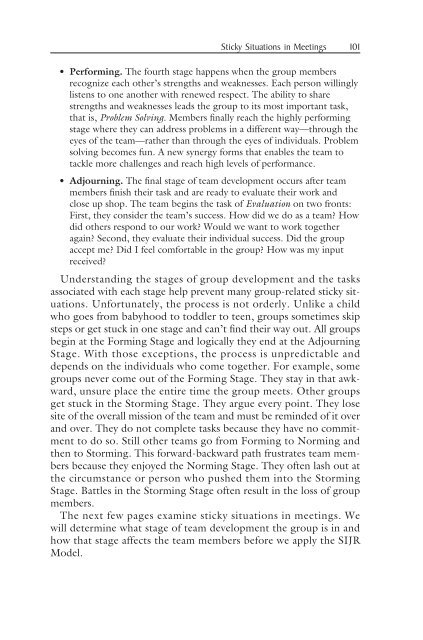Managing Sticky Situations at Work
Managing Sticky Situations at Work
Managing Sticky Situations at Work
You also want an ePaper? Increase the reach of your titles
YUMPU automatically turns print PDFs into web optimized ePapers that Google loves.
<strong>Sticky</strong> <strong>Situ<strong>at</strong>ions</strong> in Meetings 101• Performing. The fourth stage happens when the group membersrecognize each other’s strengths and weaknesses. Each person willinglylistens to one another with renewed respect. The ability to sharestrengths and weaknesses leads the group to its most important task,th<strong>at</strong> is, Problem Solving. Members finally reach the highly performingstage where they can address problems in a different way—through theeyes of the team—r<strong>at</strong>her than through the eyes of individuals. Problemsolving becomes fun. A new synergy forms th<strong>at</strong> enables the team totackle more challenges and reach high levels of performance.• Adjourning. The final stage of team development occurs after teammembers finish their task and are ready to evalu<strong>at</strong>e their work andclose up shop. The team begins the task of Evalu<strong>at</strong>ion on two fronts:First, they consider the team’s success. How did we do as a team? Howdid others respond to our work? Would we want to work togetheragain? Second, they evalu<strong>at</strong>e their individual success. Did the groupaccept me? Did I feel comfortable in the group? How was my inputreceived?Understanding the stages of group development and the tasksassoci<strong>at</strong>ed with each stage help prevent many group-rel<strong>at</strong>ed sticky situ<strong>at</strong>ions.Unfortun<strong>at</strong>ely, the process is not orderly. Unlike a childwho goes from babyhood to toddler to teen, groups sometimes skipsteps or get stuck in one stage and can’t find their way out. All groupsbegin <strong>at</strong> the Forming Stage and logically they end <strong>at</strong> the AdjourningStage. With those exceptions, the process is unpredictable anddepends on the individuals who come together. For example, somegroups never come out of the Forming Stage. They stay in th<strong>at</strong> awkward,unsure place the entire time the group meets. Other groupsget stuck in the Storming Stage. They argue every point. They losesite of the overall mission of the team and must be reminded of it overand over. They do not complete tasks because they have no commitmentto do so. Still other teams go from Forming to Norming andthen to Storming. This forward-backward p<strong>at</strong>h frustr<strong>at</strong>es team membersbecause they enjoyed the Norming Stage. They often lash out <strong>at</strong>the circumstance or person who pushed them into the StormingStage. B<strong>at</strong>tles in the Storming Stage often result in the loss of groupmembers.The next few pages examine sticky situ<strong>at</strong>ions in meetings. Wewill determine wh<strong>at</strong> stage of team development the group is in andhow th<strong>at</strong> stage affects the team members before we apply the SIJRModel.















